A coastal city submerged under water is the typical depiction of a climate change worst-case scenario. However, a Weather Channel report ranks Kansas City 5th in the top 25 list of U.S. cities to be most impacted.
Why does Kansas City rank so high?
The Weather Channel Climate Disruption Index ranks Kansas City fifth of 25 cities to be most impacted by climate change. Specifically, it states:
- “The city will see 20 more days above 90 degrees than its rural counterparts, according to Climate Central, plus more drought in the coming years.”
- “Average annual temperatures have risen, accompanied by a number of major heat waves in the last few years,” the Union of Concerned Scientists wrote in 2009, about the Midwest in general. “There have been fewer cold snaps, and ice and snow are melting sooner in the spring and arriving later in the fall. Heavy rains are occurring about twice as frequently as they did a century ago, increasing the risk of flooding.”
According to the report, the urban heat island effect will cause Kansas City to be warmer than the rural Midwest. Heat islands can develop because of buildings, roads and a lack of open land or vegetation. A 1999 report ranked the Kansas City metro area first with the most freeway lane miles per capita than any other large metropolitan area in the U.S., according to The Public Purpose journal.
Dennis Murphey, chief environmental officer for the city of Kansas City, MO, has reviewed the report and agrees that the heat island effect, drought and flooding are issues Kansas City faces now, and they will be more critical with increased extreme weather patterns. But he was still surprised that Kansas City ranked at greater risk than coastal cities like Miami.
“Despite the questions the report will raise, I’m glad to see The Weather Channel identifying that U.S. cities that will be significantly affected by climate change,” Murphey said. “I think a report like this puts the issue on the general public’s radar in a way that federal, state and local governments can’t.”
Energy, water, local food systems and public health will be the biggest issues that will stress the metro area as weather extremes increase, Murphey said. He noted that in the past few years more people have died of extreme heat than tornadoes.
What other cities made the Top 25?
The index ranks and includes rationale for the top 25 cities. They are:
- New Orleans, LA
- Minneapolis, MN
- Las Vegas, NV
- New York, NY
- Kansas City, MO
- Boston, MA
- Denver, CO
- St. Paul, MN
- Washington, D.C.
- Philadelphia, PA
- Buffalo, NY
- Baltimore, MD
- Portland, OR
- Columbus, OH
- Pittsburgh, PA
- Detroit, MI
- St. Louis, MO
- Milwaukee, WI
- Miami, FL
- Seattle, WA
- Louisville, KY
- Lincoln, NE
- Madison, WI
- Anchorage, AL
- Newark, NJ
View the full Weather Channel Climate Disruption Index.
What methodology determined risks?
The study started by looking at the top 100 cities in the U.S. with a population of 200,000 or more. They looked at six factors weighted differently including sea-level rise (2.0), extreme precipitation (1.0), extreme drought (1.0), urban heat islands/extreme heat (1.0), average temperature changes (0.5) and average precipitation (0.5). With numerical values for each factor, they added up the categories and made a list of the top 25.
The report echoes findings in the National Climate Assessment published last May that identifies urban heat islands and related health risks as issues for the Great Plains/Midwest region, said Doug Kluck, central regional climate services director for National Oceanic and Atmospheric Administration’s (NOAA) National Center for Environmental Information.
“Kansas City at #5 is a bit surprisingly high,” Kluck said. “Drought, while a potential big issue for surrounding areas, may not be as severe here in the urban area due to some pretty good flows and water availability from the Missouri River. However, heat and heavier rainstorms both will make life harder for some.”
Add the continuing strength of the El Nino in the tropical Pacific, and there is an increased risk of drought, agricultural impacts and potential for increased fire and decreased snow pack that will affect water levels, Kluck said.
How is Kansas City preparing?
Over the past 10 years, the city has taken climate protection and mitigation actions to reduce energy use and greenhouse gas emissions.
“Climate change is already manifesting itself in the form of more frequent extreme weather events, and cities are leading the way in identifying risks and vulnerabilities in order to develop climate resiliency strategies and plans,” Murphey said.
In Kansas City, those efforts include:
- In 2008, the city developed a Climate Protection Plan that identifies potential risks to the area and recommended actions, many of which have been implemented. The city has made energy-efficiency retrofits and installed solar energy on many municipal buildings. To help reduce flooding, the city is expanding the green infrastructure to capture more storm water before it flows into streams and waterways.
- The city is working with Mid-America Regional Council, Johnson County and Bridging the Gap on the metro area designation by the Environmental Protection Agency as one of 16 Climate Action Champions nationwide. This includes working with federal agencies to help determine the local urban heat island effects and how much the city could mitigate it with a substantial effort to plant trees and increase the urban canopy.
- The City Council approved an Energy Empowerment Ordinance requiring energy benchmarking for larger commercial buildings.
- As a member of the Heartland Sustainability Network, the city is working with other municipalities and state climatologists to develop realistic future weather scenarios for Kansas City, MO; Columbia, MO; Lawrence, KS; Iowa City, IA; Lincoln, NE and Oklahoma City, OK.
- Partnering with the Greater Kansas City Chamber of Commerce and other organizations, the city is implementing the City Energy Project, a three-year initiative of the Natural Resources Defense Council and Institute for Market Transformation to promote energy efficiency improvements in large commercial buildings. Kansas City is one of 10 cities nationwide in the program. Buildings are responsible for more than 50 percent of all carbon emissions in Kansas City and much of the energy consumed in these buildings is wasted.
To look at the potential risks from water shortages, NOAA is sponsoring a Missouri Basin El Nino Winter Impact webinar at 1 p.m., July 30. Designed for decision makers at state and federal agencies, the webinar is open to the public. To sign up, go to the webinar link.
What can residences and businesses do now?
“We need to target our climate resilience efforts to help those in Kansas City who are most susceptible to the impacts of climate change and who are often least able to respond to the impacts — seniors, children, low-income & fixed-income households,” Murphey said.
He recommends several strategies for residents and businesses:
- Obtain an energy audit and begin making energy efficiency improvements to reduce the overall energy needs for the metro.
- Access rebates from electric and natural gas utilities to implement energy-efficiency improvements.
- Install renewable energy systems, such as rooftop solar or geothermal systems.
- Explore property-assessed clean energy (PACE) loans for funding to implement energy efficiency and renewable energy projects in commercial buildings.
- Reduce single-occupant auto trips by utilizing public transit, ride-sharing, bicycling or walking.
- Purchase energy-efficient (high mpg) vehicles for fleet and individual use.
- Plant rain gardens and bio-swales to keep rain water out of the sewer system.
- Grow food in individual or community gardens and purchase food from local farmers.
- Plant trees, including fruit and nut trees, to help increase the tree canopy and create “food forests”.
- Incorporate low-water, heat-tolerant plants into landscaping of homes and businesses.
- Purchase ENERGY STAR rated appliances & electronic equipment.
What are you doing?
What do you think of the findings in the report? Are you taking any specific actions at home, work or in your organizations to combat climate change? Leave us your comments below.
Like what you see? Keep up with more local stories by subscribing to the free Greenability Weekly. Sign up here.






Great article! However, the listing of what Kansas City has done or is doing to reduce the impacts of climate change is incomplete. Since 1997, the City Water Department’s fleet of vehicles has been using alternative fuels that are friendly to the environment and/or have a positive impact on weather-related risks. Biodiesel, which is manufactured from local and regional crops and thus reduces the footprint of sourcing petroleum-based, foreign-sourced fuel, was used in the heavy truck fleet for many years. Then in 2009, the entire city fleet began to quickly expand its use of compressed natural gas (CNG), not only because of the price (often $2 cheaper per diesel gallon equivalent), but also because uninterrupted fuel delivery by natural gas pipelines during the historic Katrina gasoline/diesel fuel shortage highlighted the risk-management benefit of the City’s CNG-powered cars and trucks. Today the City fleet saves more than $1 million annually and also reduces its greenhouse gas output by thousands of pounds every year. The City’s Central Fleet is a leader in alternative fuel use across the country, and private and public fleets closer to home have been paying attention.
Great point Kelly! The fleet has been recognized nationally for the city’s green efforts. We wrote about it here: https://greenabilitymagazine.com/blog/2014/11/city-of-kansas-city-mo-wins-green-fleet-award/
“Heat islands can develop because of buildings, roads and a lack of open land or vegetation. A 1999 report ranked the Kansas City metro area first with the most freeway lane miles per capita than any other large metropolitan area in the U.S., according to The Public Purpose journal.” True on the freeway miles, but we DON’T have a lack of open land or vegetation. There are LARGE greenspaces all over Kansas City. Swope Park is one of the largest municipal parks in the country. Loose Park, Gillham Park, Liberty Memorial and many others dot the city. Trees are everywhere (just count the fallen ones during a storm and multiply by a million).
It is God awful hot with tall buildings creating wind tunnels of hot air. Black asphalt and concrete radiate heat. Shade trees are not required. Look at the mess they made of Oak Street by UMKC and Troost by Rockhurst. Even Stateline was redone and never shaded. The cities do not require shade trees and do not shade their own infernos. I can barely walk across the parking lots in the summer even at church because radiated heat burns my legs.